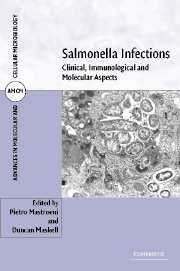Book contents
- Frontmatter
- Contents
- List of contributors
- Preface
- 1 Epidemiological and clinical aspects of human typhoid fever
- 2 Antibiotic resistance in Salmonella infections
- 3 Host-specificity of Salmonella infections in animal species
- 4 Public health aspects of Salmonella enterica in food production
- 5 The Salmonella genome: a global view
- 6 Pathogenicity islands and virulence of Salmonella enterica
- 7 In vivo identification, expression and function of Salmonella virulence genes
- 8 Mechanisms of immunity to Salmonella infections
- 9 Interactions of S. enterica with phagocytic cells
- 10 Interactions between Salmonella and dendritic cells: what happens along the way?
- 11 Immunity to Salmonella in domestic (food animal) species
- 12 Newer vaccines against typhoid fever and gastrointestinal salmonelloses
- 13 S. enterica-based antigen delivery systems
- Index
- Plate section
- References
4 - Public health aspects of Salmonella enterica in food production
Published online by Cambridge University Press: 04 December 2009
- Frontmatter
- Contents
- List of contributors
- Preface
- 1 Epidemiological and clinical aspects of human typhoid fever
- 2 Antibiotic resistance in Salmonella infections
- 3 Host-specificity of Salmonella infections in animal species
- 4 Public health aspects of Salmonella enterica in food production
- 5 The Salmonella genome: a global view
- 6 Pathogenicity islands and virulence of Salmonella enterica
- 7 In vivo identification, expression and function of Salmonella virulence genes
- 8 Mechanisms of immunity to Salmonella infections
- 9 Interactions of S. enterica with phagocytic cells
- 10 Interactions between Salmonella and dendritic cells: what happens along the way?
- 11 Immunity to Salmonella in domestic (food animal) species
- 12 Newer vaccines against typhoid fever and gastrointestinal salmonelloses
- 13 S. enterica-based antigen delivery systems
- Index
- Plate section
- References
Summary
INTRODUCTION AND HISTORICAL PERSPECTIVE
Salmonella enterica is a food-borne pathogen of global significance and no population is spared. It has been reported that there are over 1.3 billion cases of human salmonellosis annually worldwide, with three million deaths (Pang et al., 1995). More recent data suggest that each year in the USA there are 1.3 million cases of human S. enterica infections with 600 deaths. Other recent work from Denmark claims that mortality rates of people who have had S. enterica are three times those of controls, in the year after infection (Helms et al., 2003). Infection with S. enterica can lead to long-term sequelae such as irritable bowel syndrome and reactive arthritis (Rees et al., 2004). There are clear public health benefits to be had from better control of these bacteria in the food chain. In addition, S. enterica serovars have an enormous economic impact (Roberts et al., 2003; Voetsch et al., 2004), and are the most important foodborne pathogens in terms of deaths caused (Adak et al., 2002; Kennedy et al., 2004; Mead et al., 1999).
Gaffky may have been the first person to isolate S. enterica micro-organisms. These were S. enterica serovar Typhi from an infected patient, in 1884. Around this time it was also known that similar bacteria could cause non-typhoid disease in both animals and humans. In 1885, two American veterinarians, Salmon and Smith, isolated the bacterium causing ‘hog cholera’ from infected pigs.
- Type
- Chapter
- Information
- Salmonella InfectionsClinical, Immunological and Molecular Aspects, pp. 89 - 116Publisher: Cambridge University PressPrint publication year: 2006
References
- 4
- Cited by



